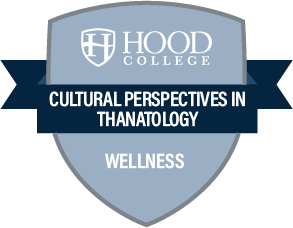Badge Overview
 Historical and Multicultural Perspectives in Thanatology
Historical and Multicultural Perspectives in Thanatology
Published Public {} Badge Class Data
Historical and Multicultural Perspectives in Thanatology

Issued by Hood College
Badge Description
The Historical and Multicultural Perspectives in Thanatology badge focuses on the role of death in Western history, noting how concepts of dying, death and bereavement have changed over the centuries. Specific topics include an overview of Ariès’ work on the history of Western attitudes toward death; a discussion of Egypt and its death-centered culture and society; and an examination of the Civil War and its role on how death is viewed in the United States. The badge also explores dying, death and bereavement as experienced in various cultures, ethnic groups and religions around the world. Groups studied include but are not limited to Buddhism, Hinduism, Judaism, Christianity and Islam, among others. Group similarities and differences are highlighted, including religious traditions surrounding death, cross-cultural mourning practices, funeral practices, corpse disposal and diverse philosophies of the role of death in the meaning of life.
Religious Literacty
Thanatology
Multicultural Communication
Cross-Cultural Competency
Historical Analysis
Badge Criteria
This FOUNDATIONAL level badge is equivalent to a 3-credit, master's level course. A final grade of B or better is required to earn this badge.
Aligned Outcomes
-
Internal
Core Competencies
https://www.hood.edu/offices-services/institutional-assessment/institutional-learning-outcomesGSO_CommCommunication
The badge earner will communicate clearly and effectively in oral, written and/or visual formats, consistent with the standards of their discipline.
-
Internal
Core Competencies
https://www.hood.edu/offices-services/institutional-assessment/institutional-learning-outcomesGSO_CriReasCritical Reasoning
The badge earner will approach content and tasks with a critical awareness, framed by knowledge and skills appropriate to their discipline.
-
Internal
Core Competencies
https://www.hood.edu/offices-services/institutional-assessment/institutional-learning-outcomesGSO_ProbSolvProblem Solving
The badge earner will apply advanced disciplinary content knowledge and strategies to understand and address problems and questions relevant to their discipline and to which they have not previously been introduced.
-
Internal
Core Competencies
https://www.hood.edu/offices-services/institutional-assessment/institutional-learning-outcomesGSO_DivDiversity
The badge earner will recognize and engage diverse ideas, perspectives and/or traditions that inform their discipline, profession and graduate experience.
-
Internal
Core Competencies
https://www.hood.edu/offices-services/institutional-assessment/institutional-learning-outcomesGSO_ProfProfessionalism
The badge earner will engage in legal, ethical and professional behaviors consistent with their discipline, including leadership, teamwork and/or other responsibilities to key stakeholders.
